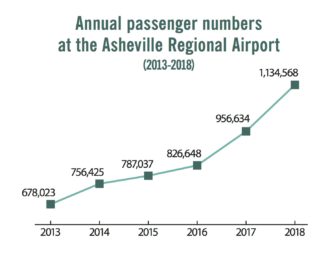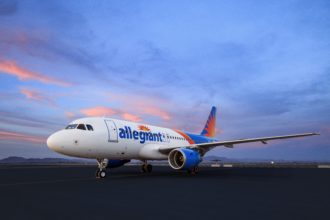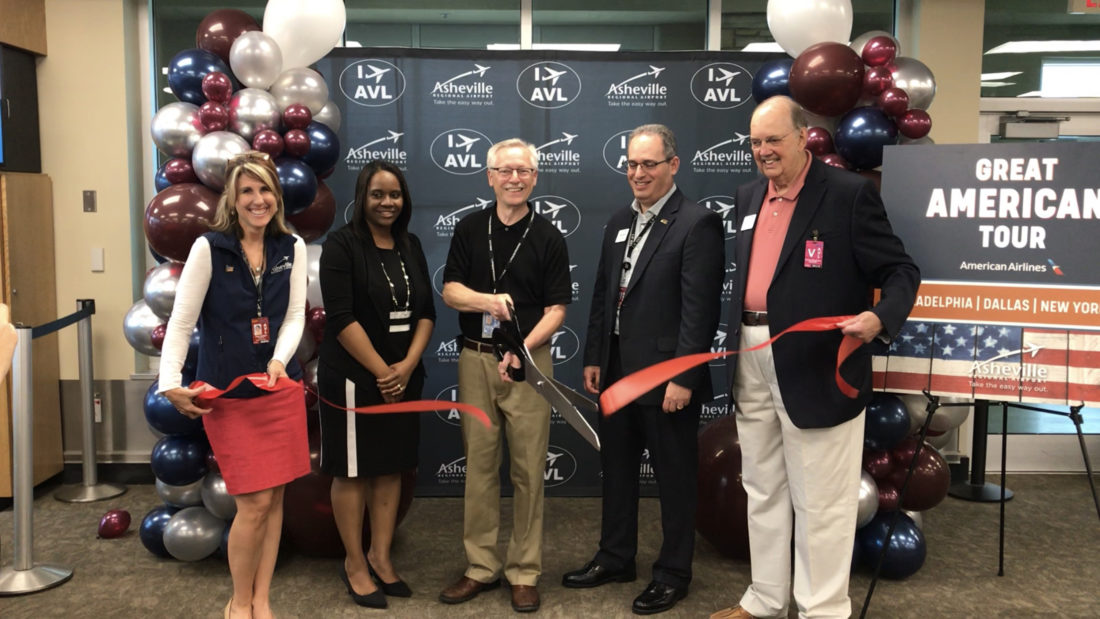Lay out a graph with the passenger numbers served by the Asheville Regional Airport over the past several years, and the result looks similar to the takeoff pattern of a jumbo jet. From a runway of roughly 678,000 fliers in 2013, the count climbs steadily upward before spiking toward the proverbial clouds.
Last year, AVL hosted over 1.13 million passengers, an 18.6% jump from 2017’s total and over 67% more travelers than used the airport five years prior. Both the total number and growth rate are records for the facility — but Tina Kinsey, the Greater Asheville Regional Airport Authority’s director of marketing, public relations and air service development, says that skyward flight is still far from its final destination.
“Everyone’s growing, but we’re really growing. It’s pretty significant,” Kinsey told a meeting of the Buncombe County Tourism Development Authority on Aug. 28 as she compared the airport to its regional competitors. AVL had 42% more seats for sale from August through October of this year than were available during the same period in 2018, she said, compared with 8% growth for the Greenville-Spartanburg International Airport and 17% growth for the McGhee Tyson Airport, which serves Knoxville, Tenn.
As any good pilot knows, however, a too-steep climb can cause an airplane to stall out. Speaking with Xpress, Kinsey says the airport is now striving to manage its expansion and ensure its long-term path maintains a steady cruising altitude.
“We’re in a period right now where we’re really working to support our airline partners and their success in the market,” Kinsey explains. “We certainly want what’s here to be successful and retain that for our region’s travelers.”
All at once

The airport’s facilities — parking lots, terminal and airfield — “can really accommodate quite a bit of growth” as they are now, says Kinsey. The biggest limitation, she points out, is not overall passenger volumes but “peak activity,” or how many travelers come through AVL at any one time.
According to a study conducted last year by consultants CHA Design/Construction Solutions and Leo A. Daly, the airport’s busiest month is October, when it averages over 3,400 passengers per day. During its peak period, 4:15-5:45 p.m., approximately 716 passengers arrive at or depart from AVL. That figure is expected to grow to 829 passengers by 2023 and 1,168 by 2038, a more than 63% increase.
Kinsey says the airport has implemented a number of short-term projects to reduce the pressure at peak times. In the terminal itself, for example, walls have been removed and offices reconfigured to expand the ticketing lobby area for waiting travelers.
Parking went up by 1,100 spaces with the completion of a five-story garage last year, and Kinsey says nearly 400 new spaces will become available after a shuttle lot is finished across Airport Road (U.S. Highway 280) at the former site of J&S Cafeteria. Airplanes are getting more places to park as well: An expansion to the north terminal ramp wrapped up last year, and a similar project for the south ramp is now underway.
How quickly the airport can process planes is also set to increase in the near future. Although Kinsey told the TDA that Project SOAR, a $75 million initiative to replace AVL’s runway and add a new taxiway, has been delayed due to unspecified “contractor issues,” officials hope to commission the runway by the end of the year.
Flight of facility
Despite these moves, the airport’s growth is straining its ability to keep up. The 2018 consultants’ report, Kinsey says, concluded that AVL’s over-113,000-square-foot terminal was at its peak capacity and needed to expand. By 2023, the report projects a demand for more than 221,000 square feet, with nearly 276,000 required by 2038.
At an estimated cost of $150 million-$200 million, the terminal expansion represents a heavy lift for an airport with an estimated profit of roughly $1.8 million last fiscal year. Lew Bleiweis, the airport’s executive director, says a key piece of funding for the new terminal is a higher passenger facility charge.
Currently set at $4.50 per flight segment, the PFC is a federal fee added to all passenger tickets that airports can use to pay for infrastructure projects. Bleiweis hopes to nearly double the fee to $8.50, a move that would require congressional action.
“The PFC needs to increase — it is so important to our nation’s airport infrastructure and, on a local level, to AVL,” Bleiweis says. “I have advocated to all of our elected officials to support the PFC increase and I have been encouraged that our elected leaders are listening and gaining a deeper understanding of what the funding means to our aging airports.”
U.S. Rep. Mark Meadows, who sits on the House Committee on Transportation and Infrastructure and whose district includes the airport, generally supports raising the fee, according to spokesperson Ben Williamson. “We’re in close touch with local airport officials pretty frequently and certainly want to make sure their needs are met from a federal standpoint,” he says.
Even if the PFC funding comes through, the terminal expansion and other capital projects will have to contend with the airport’s physical constraints. Existing roadways and geographic features, Kinsey says, may prevent AVL from growing its footprint.
“We always watch for opportunities for land acquisition,” Kinsey explains. “However, because we are bordered by Interstate 26 to the north and the French Broad River to the west and south, opportunities are very limited.”
Steady as she goes

For now, Kinsey says the airport’s top priority is maintaining its recently added service. Five of AVL’s six airlines have established routes or expanded existing flights since the start of 2018, including three flights to Florida destinations by Spirit Airlines that began last September and a nonstop flight to Denver, the airport’s westernmost destination, operated by Allegiant Air.
Further growth plans, Kinsey explains, will be driven by data on passenger origins and final destinations. Public information from the federal Department of Transportation, as well as details collected from passengers who opt in to fast WiFi at the airport, help AVL officials determine where unmet demand exists.
“If it makes sense, we talk with our airline partners about the possibility of a nonstop flight to that particular destination, or we may help them see that there’s a strong demand to a specific destination, that perhaps more seats on connecting flights might serve our region well,” Kinsey says. “It’s all about trying to connect the dots and make sure that we’re growing appropriately.”
The TDA, Kinsey adds, has provided “talking points” to help convince airline planners that AVL is worth an investment of their limited routes and airplanes. The tourism authority’s marketing expertise, she says, can give airlines “a clear image, a picture, an experience, an understanding” of the area that might push Asheville over other destinations.
Both new and existing routes depend on a ready supply of pilots, which airport officials have listed as a challenge. According to Tim Anderson, who chairs the aviation management and career pilot technology program at A-B Tech, the personnel crunch results from a combination of aging pilots, increased recruitment by foreign airlines and new federal regulations.
A 2013 rule instituted in response to a 2009 regional airline crash, Anderson explains, requires all regional airline pilots to have 1,500 hours of total flight time, up from a previous requirement of 250 hours. “It can take years and many tens of thousands of dollars to build 1,500 hours,” he says. “Consequently, many people are choosing other, more accessible careers, and the pool of qualified pilot applicants from which the airlines have to pick is much smaller.”
Thanks to a federal exception, Anderson continues, A-B Tech offers the only two-year program in the Carolinas that allows students to qualify for Airline Transport Pilot certification at 1,250 hours instead of 1,500. The college also partners with Piedmont Airlines, a regional subsidiary of American Airlines, to offer internships for its graduates.
Watch the skies
As outlined in its consultants’ report, AVL’s growth projections show a smooth and steady increase through 2038 — a pattern that assumes a lengthy period of business as usual. That certainty, however, is up for debate: Asheville officials have raised worries over a possible economic recession, and Buncombe County set a goal in 2017 that would have the entire community, including the airport, use only renewable energy by 2042. All commercial aircraft are currently powered using nonrenewable fossil fuels.
The air travel industry has come under increasing scrutiny for its contribution to a changing climate. According to the U.N. Intergovernmental Panel on Climate Change, aviation accounts for roughly 3.5% of all human climate impacts, and U.N. scientists have called for “rapid and far-reaching transitions” in transportation infrastructure to avoid the worst consequences of climate change.
“The existence of carbon emissions in aviation is a complex and important issue that is being addressed in many ways within the industry,” Kinsey says in response to a question about AVL’s handling of climate concerns. She points to environmental measures such as the installation of energy-efficient lighting, use of on-airport electric vehicles and a recycling program.
The airport, Kinsey says, believes in the strength of its future prospects. “The growth we are experiencing is due to many factors: advocacy, yes, but also the result of the sheer vibrancy of Western North Carolina,” she says. “Airlines will grow where they can have the best customer base, and we are one such place. And the growing connectivity is excellent for our region — both from an air service perspective and an economic perspective.”




Before you comment
The comments section is here to provide a platform for civil dialogue on the issues we face together as a local community. Xpress is committed to offering this platform for all voices, but when the tone of the discussion gets nasty or strays off topic, we believe many people choose not to participate. Xpress editors are determined to moderate comments to ensure a constructive interchange is maintained. All comments judged not to be in keeping with the spirit of civil discourse will be removed and repeat violators will be banned. See here for our terms of service. Thank you for being part of this effort to promote respectful discussion.